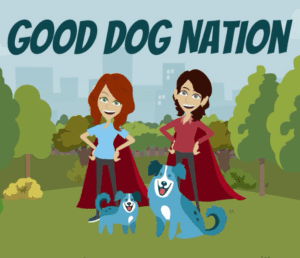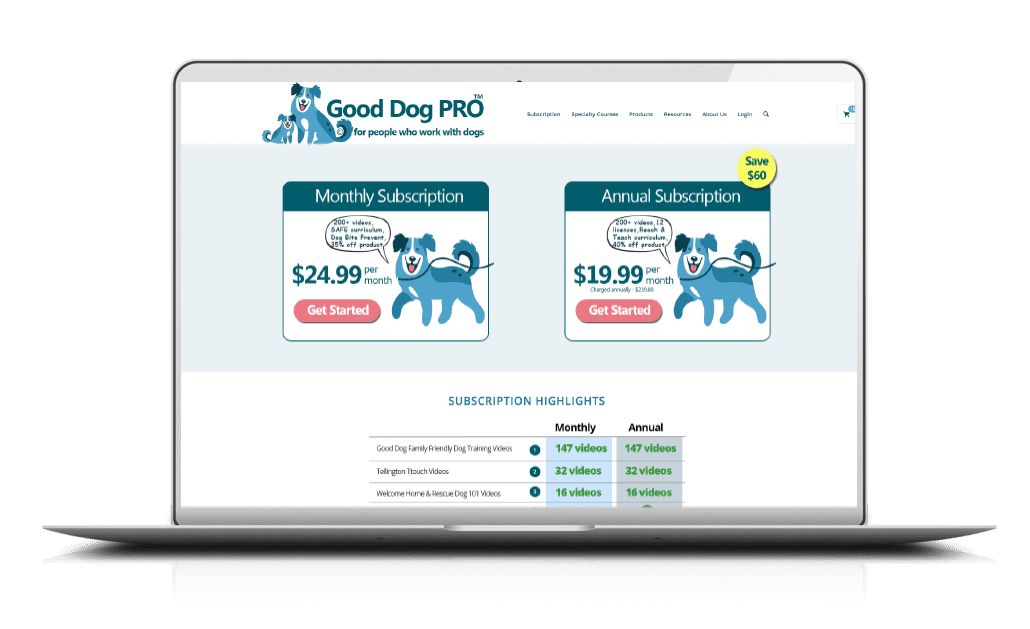This episode is eligible for the following continuing education (CE) credits:
To earn continuing education credits you must be a member of Good Dog Pro and watch the full 1 hour episode of this podcast in our learning management system. Sign up for Good Dog Pro and start earning continuing education credits today.
*CCPDT 1 CEU for trainers.
Kim: Hello everyone and welcome to Good Dog Nation, the video podcast that talks about all things dogs. I am Kim Merritt, co-founder of Good Dog In A Box and Good Dog Pro, and I’m here with my co-host Michelle McCarthy of Canine Home Schooling.
Michelle: Hello!
Kim: And we have as our guest today, Stacy Butler. So in 2016 Stacy left her career in nursing to follow her dream of owning and operating her own dog grooming business. She opened For The Love Of Roscoe dog grooming in September of 2016, she is an accredited pet first aid and CPR through the Canadian Walks and Wags program, and last year she became fear free certified in their grooming program. So welcome Stacy, we’re so glad to have you today.
Stacy: Thank you!
Kim: So why don’t you tell us how the whole thing with dog grooming came up, how you got interested in that, and how you decided to leave nursing to go into dog grooming.
Stacy: Well, basically, I had a few friends that were dog groomers that I would just help out when they needed it at Christmas in their busy season. But I have a special Newfoundland dog named Roscoe, he had both of his hips removed. So we went through about a year-and-a-half of surgeries and rehabilitation, so he does require a lot of grooming, an excessive amount of grooming.
Kim: No, Michelle and I have been. We were both Newfoundland owners, we feel your pain.
Stacy: Now I was able to do this at home to a certain point, but then when he got almost too big to fit in my bathtub, I needed to look at Plan B. And that’s when I discovered, nothing against any of the groomers in my area, but I couldn’t find a grooming shop that I felt comfortable leaving him at because of his sort of disability. The shops were not set up for dogs like him. So finally, life is short and we all say, we’re going to do everything later, tomorrow, next week, when we retire. And I just said if I’m going to fail, I’d rather have $5 in my pocket and be happy than $5 million and be miserable. So I just said, “That’s it,” and I quit my job and I enrolled in dog grooming school because that was my dream. So I completed the course and opened my own business two days after I got my certificate from the dog grooming school. In hindsight, I wouldn’t recommend that, but anyways it’s worked out for me. I always followed the Fear Free mission from day one. I didn’t know it was the Fear Free mission., it was just the Stacy mission. And then I learned of the Fear Free program and then I waited and waited because I knew that the dog grooming certification was going to be available soon, but it wasn’t yet. And then finally it was done, I immediately signed up, and couldn’t be happier to have it. I wish all groomers in the world had this course.
Kim: So tell us about it. I have known Marty Becker, the creator of Fear Free, for several years, I’ve had his daughter McKell on with different webinars and things we’ve done, and it’s just, it’s a fabulous program. It was started for vet clinics and has kind of migrated now to dog trainers and now groomers. So tell us, what does the Fear Free program for groomers look like? What does that mean to a pet owner?
Stacy: Well basically the main focus of it, like all the other fear free programs, is we try to do absolutely everything we can to reduce the amount of fear, anxiety, and stress to the pet during the grooming process. And that is the end goal. Dogs don’t always love their grooming and they don’t have to love it, but they also shouldn’t be ready for a nervous breakdown because of it. There’s a happy medium there. I’m not saying that Fluffy has to count down the days until he goes to see the groomer, he’s so excited. But he shouldn’t be suffering a mild heart attack either by the end of it. So it’s all about reducing the fear, anxiety, and stress as much as possible to make it bearable for them with the least amount of stress.
Kim: So give us some examples of how you do that.
Stacy: Choice is a big thing, and there are a lot of things that are right in front of you that are common sense you may not always see until they’re pointed out to you. So giving the dog a choice can make an entire world of difference during the grooming process. For example, when I take a dog in the back room to the tub, most dogs walk happily beside me until right when they get to that tub, and then the brakes go on. Instant fear, all four legs splayed out like I’m dragging them to their own death. And at that point many groomers, not again saying anything bad about them, but they either pull on the grooming loop to force them into the tub, and if that doesn’t work, if it’s a 10 pound dog, many of them will just scoop the dog up and place the dog in the tub. But they’re removing the dog’s choice in those scenarios. So what I do instead is hang onto the grooming loop, I do not pull on it at all. I do hang onto it so that I’m not allowing the dog to back up and go away from the tub, but I’m in no way trying to force the dog to the tub either. And there are different ways depending upon the dog, some dogs are very food motivated and with a little piece of liver I can have them do in cartwheels in that tub. But some dogs are like, “I will starve to death before I get in that tub.” Whether you’re using praise and love or liver or whatever the thing is that you find for that particular dog. Now when that dog moves one inch towards me in that tub, I act like I won the lottery. Positive reinforcement. If anybody saw me, they’d probably have me put into the psychiatric unit. I dance and I sing and I make such a big fuss that this is the best dog in the world for that one inch that they moved towards the tub. In a few more minutes, they might move another inch. Now when all is said and done, it depends on the dog. Sometimes it’s 30 seconds. My longest was a Newfoundland dog, and it was one hour and 27 minutes that I sat in the tub and he sat outside of the tub. Now that’s rare. It doesn’t usually take that long. But the funny part of this story is after one hour and 27 minutes, the dog entered the tub and sat down beside me in the tub of his own free will. So that was a huge win because you have to look long term about this dog grooming. He’s got 10 years left to be groomed. I would rather take all this extra time today and have him readily and happily walk into my tub, then fight with him every eight weeks and wrestle him into that tub.
Michelle: For the rest of his life.
Stacy: Yep. So when you remove somebody’s choice, even a human, you think about it for a moment. If I’m asking you to come into a store with me and you’re not really sure you don’t want to go, and I say,”Well that’s too bad whether you want to go or not.” So I grab you by your hair and your jacket and I drag you into that store. Well, you’re going to kick and scream and do everything in your power to get out of that store. And the dog is no different. You have to put yourself in their shoes.
Kim: Well, and kudos to you there. I’m thrilled to hear that. Because not every groomer would take an hour and 27 minutes out of their day. But I totally can understand and I would have to guess that from that point on, did that dog willingly go into the tub for you?
Stacy: Every time after that he followed me and did not put the brakes on when we got to the tub, he walked in. Now I know it was an hour and 27 minutes, but look at how much time I spent simply by getting that dog in the tub every single time he came to the shop. So for me it’s a bonus. I know many people who think time is money and, without getting into this too much, but it also depends on your client. Because the big problem with practicing Fear Free most of the time is not the dog, it’s the human that brings the dog to the grooming shop. They need to be on board, and a lot of the times they’re not. And at that point, your hands are tied.
Kim: So is that because they don’t understand what Fear Free is, or is that because they don’t practice reward-based dog training at home?
Stacy: I find sometimes it’s a little bit of everything, but the two factors that I’ve seen in my shop are money and time. As much as I love dogs, I can’t work for free. So in the beginning to get the dog used to the grooming, it takes time. I always tell people, if your five-year-old dog is petrified to have their nails clipped, this didn’t happen in one day. This has been building for five years, building fear in this dog. And a lot of people believe that they’ll bring the dog to my shop and I will clip the nails and there will be unicorns floating through the sky and everybody will be happy and sometimes it takes many visits before I can get the nails trimmed. So that’s many visits, they have to take time out of their busy lives to bring the dog to the shop, and they do have to pay every time. Some clients would rather I hog-tie the dog, sit on it while it wails and I just clip the nails. They just want it done and they don’t care how I do it.
Michelle: Can I ask, Stacy, say someone really does have a dog that’s really terrified and you’re working with them, how much compliance do you get if you ask that client to continue practicing these handling exercises at home between groomings? Do you get compliance with people?
Stacy: That’s a tough one. I would say yes and no. Half of them do comply, half of them don’t. The problem is even the ones they want to comply, but they have such difficulty at home because they’re Mom to that dog. And most of the time dogs are like night and day from your home to my shop. They’re completely opposite. When people come in and tell me how much Fluffy loves their bath, I’m like, “Oh good God, this is going to be a nightmare.” But if they come in and say they’re all worried, and they’re all anxious, and they’re scared of what how dog will act, and it might bite me because it hates bath, so much. I’m smiling because I know this dog is going to be an angel in my tub. I can almost bet you $100 on every dog that they’re opposite from what the client tells me once they walk out the door. Yeah.
Kim: So are there different exercises and things that you tell your clients to do in between?
Stacy: Yes. If you’re talking about nails, I find a big mistake is how we handle the paws. People touch the paws, you pick up the paws, which is all fine. I don’t normally have a problem with a dog letting me touch its paws so much, but you have to kind of get in there and spread their toes, move the fur back from the nail. It’s all those little things that happen during a nail trim, it’s not just simply touching the dogs paw. You have to go a little bit further in handling the paw than simply placing your hand on it, right? Because to do a safe nail trim, you have to be able to have a slightly firm grip. It’s one thing to pick up their paws and another to have to apply any pressure to that paw and hold on to it. And how much is too much pressure, right? If it becomes uncomfortable for the dog, then you’re at a whole new ball game. It’s not just about the nails anymore.
Michelle: So if we’re talking about a dog that has a chronic injury orthopedic problem, we’re pulling that paw forward. You probably need to sometimes even do a health intake from people.
Stacy: Oh yes, that’s another issue too. A lot of people don’t inform you. I mean, you can ask questions, but a lot of clients aren’t exactly honest and forthcoming with what they tell you about the dog. So when you get an elderly dog, now I’m not talking about any health problems other than just a senior dog that has some arthritis. I experienced this recently, I lost my Rottweiler, he was 11-and-a-half, and his knees weren’t good. Now he let anybody in the world clip his nails his whole life, but the last 12 months or so, nobody could get near him to cut his nails. He would growl. So I talked with my vet, and again, it’s something that was so obvious and made sense, but I had not thought about. She said, “The reason he’s reacting this way is you’re picking up his paw to trim the nail. You’re bending the knee, it’s hurting and it’s uncomfortable. It’s not the nail trim he’s growling about. You’re hurting his knee.” Well then after I cried and felt horrible, so I continued to groom him and to cut his nails, and I found a way to cut his nails without picking up his paw. And he never growled at me and we had no issues. But something as simple as that can make a world of difference.
Kim: So for our pet owners, maybe this is new information, they’d not heard a Fear Free before. They never even thought about what type of a groomer they’re going to and how they’re handling their dog. Are there long term negative effects to a dog that has been to a groomer who, and I don’t want to say mistreated because it could simply be be handled by a groomer who perhaps just doesn’t even know that they’re causing the dog pain. Are there long-term effects from accidental or unintentional mishandling?
Stacy: Yes, the biggest one that I deal with is, and I’m not going to state any names, but there are a few large pet store chains that offer grooming. And I have so many clients with pets that have been traumatized and now have extreme fear from the dryers in the grooming salon.. And it’s because at a big chain like this where you can walk in, you don’t need an appointment, they have multiple groomers and they have a high turnover rate. So you can go 20 times and you might never have the same groomer. Continuity of care goes a long way, too. You need to get to know that dog, that dog will respond better to somebody that’s handled it repeatedly than a perfect stranger, that’s common sense too. So in these bigger grooming shops, a lot of the times dogs will be kenneled, stacked on top of each other, and their cage dried, which basically is a big hose that attaches to the door of the kennel and it blows forced air through the kennel. They will put the dog in that kennel and then they will walk away to bathe three more dogs, which will then go in the kennels to be dried. I’m not saying that those people are bad, everybody does things differently, I do not cage dry, animals have died being caged dried that weren’t being watched. There was a Newfoundland in the States that overheated after being left in there too long and lost its life. So if a dog is petrified of the noise of the dryer or the air going in and you put that dog in a little tiny box and you put the air on it so it cannot get away from that air. First of all, you want to talk about choice while we just removed all of that, right. The dog is in fight or flight mode and it can’t flight. So some dogs will have no control and their bladder and their bowels will let go. And that’s extreme fear, that’s the worst of the worst. If you’ve got a dog that’s so scared it cannot control it’s bladder and it’s bowels, that’s pretty sad. Nothing against the groomers, they’re not standing there to watch the signs and the body language and how the dog’s reacting. They might peek in, “Oh yeah, the dog looks okay.” Well the dog is sitting there, trembling in fear. And I’ve gotten a lot of those clients, and I don’t normally say anything, but when it’s the big chain like that with the exact same scenario, after 50 clients, you start to notice a pattern. Within 50 seconds of clicking the dryer on, I can tell you where they took that dog to get groomed. So there is definitely a pattern and it does make a huge long term difference and can really affect how the dog goes about. It’s grueling for the rest of its life.
Kim: So with somebody who is looking at getting a new dog, let’s even say puppies, what can a pet parent do with that new puppy from day one when they bring it home to get it ready to start coming to the groomer?
Stacy: Well, you can’t start too young. First of all, when you get a puppy, you don’t have to wait. Start now. And I tell them they can do things at home. Most importantly, puppies have no attention span. You might get three seconds out of them, so people can’t sit there for 15-20 minutes and brush their puppy, of course the puppy is going to fight them and then start mouthing them and run away and squeal and it’s going to be a nightmare. Slow and steady wins the race. Start off by just placing the brush next to the puppy, let the puppy sniff it in a couple hours, try again and maybe put it closer to the puppy or maybe touch the puppy with the brush. You know, you can’t go slow enough. It’s much better to go slower than to try to speed things up and you’re going backwards is what’s going to happen. And I have meet and greets, I have a lot of clients that will tell me they’re getting a new puppy and the puppy will be, say, 10 weeks old. So I usually tell them once they have the puppy at home for two weeks on average that they make an appointment and they bring the puppy for the first meet and greet. It’s about 10 minutes if that. And I do not charge them. It’s free of charge. They bring the puppy to my shop, I meet the puppy, I play with the puppy, I rub its belly and I give it treats and then they go home. Nothing is done to the dog, no dryer, nothing scary happens. It is all positive belly rubs and treats, and they’re on their way. And then within a week or so they come for appointment number two. Now when they come for that appointment and they bring that puppy back to my shop, the only association that puppy has with me in that shop is, “That’s the really nice lady that rubbed my belly and gave me treats!” So they’re usually pulling their own or running to the shop to see me. Yeah. So I have many of those appointments set up and on the appointment, number two, they do pay. I don’t give away everything for free. They don’t get a full groom, but I introduce them to sounds and tools and a brush and the table, that’s about all that’s done. They don’t get anything done to them. It’s to let them familiarize yourself with the shop. I judge their reaction to things, every puppy is different. Sometimes I turn the dryer on and the puppy does not even turn around to see where the noise is coming from. It’s a process and it’s a slow process.
Kim: So talking about grooming, obviously there are different types of grooming, different grooming needs for different breeds of dogs. And my sister, co-founder of Good Dog In A Box, probably the best advice she ever gave me and my family when we were trying to find a dog 10 years ago when my children were little, was to think about the breed and what it was originally bred to do. Some dogs were bred to be fighters, some dogs were bred to be draft dogs, some dogs were bred to hunt and do all these different things. Think about what the dog was bred to do, and then that will help you to choose the right dog. You have to think about what their inherent skills are. As far as training, we ended up with a Newfoundland and I was very, very happy. One of the few breeds where part of the breed standard is their personality, they’re very docile and wonderful. They were a grooming nightmare though. So in the whole process of picking a dog and figuring out what kind of a breed you want, even if it’s a dog from a shelter, what do you say to somebody looking for a dog as far as what they want to consider? Time, money, effort, the whole grooming thing. From the professional point of view.
Stacy: I’m not often speechless. I don’t even know where to start. My dream would be that anybody that wanted a dog would have to fill out a very detailed questionnaire, and they would be given the dog matched for them and they would not be allowed to see the dog. Because I believe that one of the number one reasons we have so many dogs dumped at shelters is because people do not research the breed they are getting, and they have no idea what they’re in for. The Newfoundland for example, thrilled with them, but it’s a full time job, 24-7 outsmarting them. And I’m not always successful. They do require a lot of grooming, I spent hours upon hours upon hours weekly with maintenance and grooming my three Newfoundland dogs. So when you’re picking a breed of dog, everything’s important. Like you mentioned about what they were bred for, what type of lifestyle do you live? If you want to eat potato chips on the couch for your life, you probably shouldn’t get a Border Collie. So that being said, when it comes to the grooming part of it, and I shudder to say this, I’m going to use the doodle as the example. I have so many doodle clients who were not told anything about their grooming needs, and then when they come to me and they quite often want their doodle to be in a three inch long haircut so they look like a teddy bear that’s stuck its paw in a light socket, and they don’t want to brush their dog and all, and they’d like to bring it to a groomer every four to six months. And the reality is with a doodle, they’re a very curly coat breed bred with the thickest coat they can find and they put together and it’s sort of this smorgasboard of like, “Surprise, what type of coat are we going to get?” Most of it is all a nightmare. So their grooming is one of the highest maintenance groomings out of all the dogs I groom. They require daily brushing, and usually it’s a four to six week schedule that they come to me for a full groom, and my doodle prices start at $85. That’s for doodle to walk in the door and it goes up from there, and let me tell you, it always goes up cause they’re always matted.
Michelle: How uncomfortable, I’ll even say painful, is it for a dog who has been left five, six, seven months without a groom, who is completely matted down to their skin? How much discomfort is that dog living?
Stacy: I can’t imagine, to be honest, Michelle. I know that a lot of the time people aren’t educated, and when I tell them I almost feel bad, but I have to tell them that they don’t understand how painful it is for the dog when they’re in that condition. Dogs walk on four feet, unlike us, so every step the dog takes they’re moving four feet, four legs. If you had a huge knot in your hair, a massive mat, and I grabbed it and started hauling you around the room by it, that’s pretty much what they feel like with every step they take. It is extremely painful, and that brings us into one of my main issues I deal with, and that’s neglect. And neglect is abuse. I know that you can call it what you want, but when you get an animal, you know it’s your responsibility to care for that animal and make sure it is healthy and in good physical shape, it’s fed properly, just like when you have a child. So when you don’t get the dog groomed for a year, we call them once a year grooms and there are lots of them out there and that dog is in excruciating pain. I’ve seen dogs that stopped doing stairs and the owners think it’s because they’ve got arthritis or they’re getting old. They can’t move. It’s too painful. They can’t go upstairs because of the mats. It is a serious case in neglect, and here in Canada where I am, there’s nothing anybody does about it. There’s nothing I can do about it, there’s nobody I can call. So I try to educate the owners as much as possible and hope and pray to God that they listen for the sake of their dog.
Michelle: When Kim and I first talked about having you on, we were so excited because of your background and your experience, but to really shed light on what the grooming experience is like for the dog. Because I don’t know that we focus enough attention on that, that this is happening to the dog. I think we have to, you know, we’re so happy to have you share this because this is their experience, not ours. We lose sight of that. Like you said, you know who do we report these things to when a dog is going for a year without being bathed and groomed? With the skin conditions that come from that, and the pain, and the discomfort, and it’s very disheartening. And it is education and it should start with breeders, but it should also then transfer to the vet.
Stacy: It should be a team effort between every pet professional dealing with the pet and the owner.
Michelle: I can tell you how many students of mine, I’m reminding them, I’m referring them to groomers. They’re at this process now where I’ll touch a dog and I can feel that they’re matted down to their skin.
Stacy: A lot of people think that if your dog doesn’t cry out in pain, it’s not in pain. Dogs are very resilient. They can be in severe pain due to matting walking down your driveway and they’re not going to scream in pain. It doesn’t mean they’re not in pain.
Kim: So Stacy, I want you to give us recommendations for our pet parents out there, since we’re at the end of the show. As a pet parent, what do you want to look for in a groomer? How do you pick one and what questions do you want to ask to make sure you’ve got the right one?
Stacy: Well, for starters, now I’m not saying anything, some of the best groomers in the world are self-taught. But as a whole, I would definitely make sure that they had training and schooling and some type of certificate that they went to school. If it was me and my dog, I would want them to be certified in pet first aid and CPR. That’s a big one. Anything can happen to a dog, whether it’s at the groomer and or in your home, the person that grooms, your dog should be trained for any medical conditions that may arise as best as they can until they get them to the vet. Talk to people. Now I realize if you’re in a huge city, which I’m not, but read the reviews, Google the people. It’s amazing what you can find out about people through Google. It’s a very simple process, so check out their credentials and what people are saying about them. If you know anybody in the pet profession, whether it’s a vet or a trainer or anybody, ask them if they know of any good groomers or ones to stay away from, find that stuff out. And this one is a biggie because this is how I am, and you might laugh, but trust your gut. So many stories of people that took their dog to a groomer, something horrific happened or was a bad experience, and they tell me, “You know, I almost didn’t leave him there and I had this feeling.” And for God sakes, people, if you go dropping your dog off with a stranger and you have this feeling in your gut for whatever reason, that this is not a positive, happy experience, don’t feel bad that you’re going to take your dog and walk out. You have an obligation to this dog. So even if I’m not saying the groomer’s bad, but for any reason that you don’t feel comfortable and you don’t think this is a good match for you, just turn around and walk out.
Kim: Good advice. Well, Stacy, thank you so much for joining Michelle and I today. This has been very valuable information for everybody out there who owns a dog and has to have it groomed. I mean, we all have pets that require grooming, and this has been really great information for everyone, so thank you so much for joining us.
Kim: If you’d like to participate in the rest of today’s conversation for professionals who work with dogs and receive continuing education credits from participating organizations for listening, visit GoodDogPro.com and subscribe today. Use coupon PODCAST to get 40% off your first month or annual subscription.
Michelle McCarthy, CDBC, has been the Owner and Director of Training for K9 Home Schooling since 1999, which provides force free/clicker training methods in southeast Michigan. She is a nationally recognized Certified Dog Behavior Consultant and Certified Therapy Animal Consultant with the International Association of Animal Behavior Consultants (IAABC). She has completed advanced certification programs in canine behavioral studies and has 18 years of experience working with complex behavior problems. For the past 10 years she has worked closely with medical professionals and educators who utilize a Therapy Dog at their work place or in Animal Assisted Play Therapy. She has raised, trained and placed Therapy Dogs who work in medical facilities and private practices around the US.
Kim Merritt is a serial entrepreneur who started her first company, Kim’s Khocolate, at eleven years of age. As a teenager, she was discovered by Guy Kawasaki who invited her to make custom Khocolate for Apple. Kim went on to do business with The Rolling Stones, AT&T, MCI, Becton Dickinson, Bausch & Lomb, and Range Rover. Her second company, an e-commerce play, sold brand name dinnerware and home decor items across North America. She founded Good Dog in a Box with her sister, professional dog trainer Jenn Merritt, CPDT-KA. Her love of dogs and kids has pushed her to develop and co-develop a number of products, online training courses, and curriculums revolving around dog bite prevention and dog safety. Her latest endeavor, Good Dog Pro, is a subscription based online education system and community for dog professionals.
Subscribe to Good Dog Pro for Full Access To Our Video Podcasts
Good Dog Pro members get full access to both our video podcasts, plus 200+ reward based training videos, dog bite prevention and humane education curriculums, discounts of up to 75% off Good Dog products and courses, webinars, and so much more!











I was unsure how this podcast was going to go but I’m so glad I watched it. I’ve been a groomer for more than 20 year and we have a huge need for more fear free grooming. The amount of unnecessary stress in grooming salons is over whelming. I hope before my career is over I see this take a different direction. Thank you for this.
Shondra, I’m so glad you found value in this podcast. I thought what Stacey was doing in her grooming business was just spectacular!